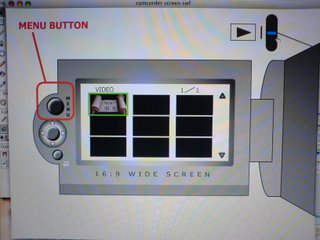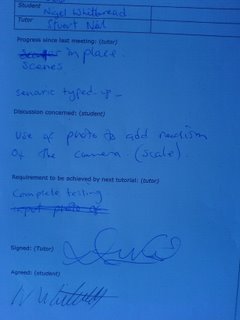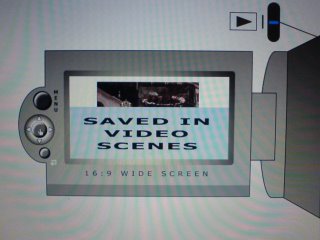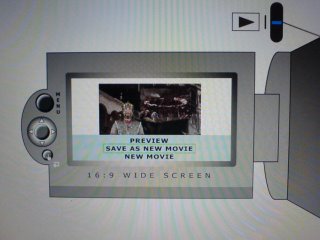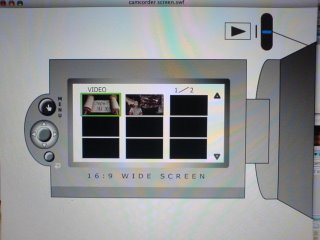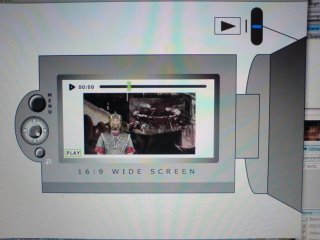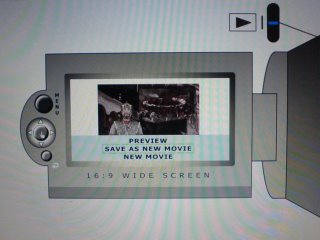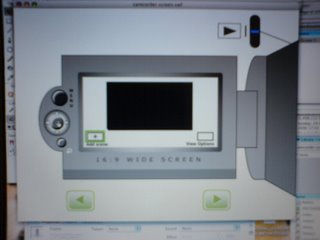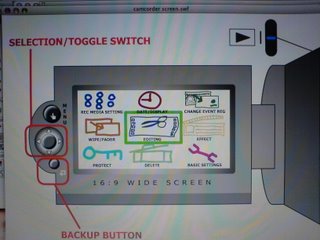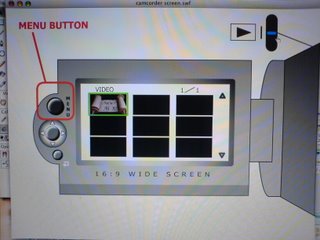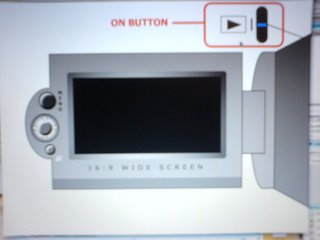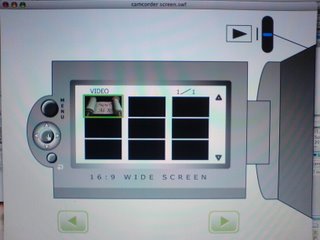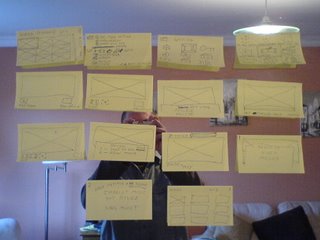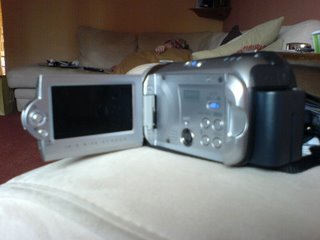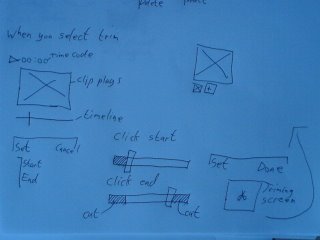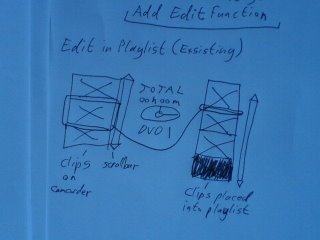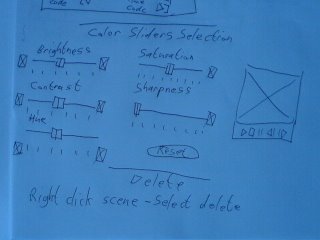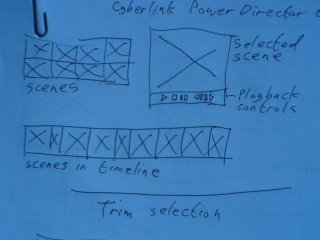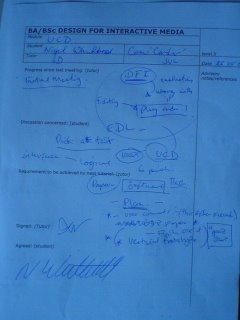Tuesday, December 12, 2006
Professional Organisation Visit
I found talking to Richard really helpful and he gave up a lot of his time to talk to us, and for that I for one thank him
http://www.sequence.co.uk/index.html
Monday, December 11, 2006
Production Processes (ADM304) Live Brief
CREATE AN INTERACTIVE ADVERT PERSUADING PEOPLE
TO GET AN ONLINE QUOTE FROM NPOWER
Further information
www.npower.com
www.urbancricket.com
www.fan-power.com
www.orbworld.com
www.dandad.org/student awards07
Sunday, December 10, 2006
Presentation for Contemporary Contextual Studies
Machinima (pronounced Machine-ama)
Saturday, November 25, 2006
Tuesday, November 21, 2006
Analysis of Eclipse Creative Website
I looked at www.atticusmedia.co.uk
and www.no-brake.com as well.
Eclipse Creative deal with Graphic Design, production for television, print, and New Media.
Some of their clients include:
- Channel 4,
- S4C,
- Wales Quality Centre,
- Ladbrokes,
- Plumbline,
- WDA,
- Bafta Cymru,
- Wales Screen Commision.
- Brand animation ising image packages and after effects
- TV Titles
- Video Editind
- Live action filming
- Music Festival Titles
- Childrens TV Series Titles
- Modelling and Animation
- Promo Videos
- Website Design
The good points of the site are: the images in the centre of the site directly relate to videos that they are linked to when you click on them and you get good background desriptions of the work produced and the videos play without a hitch. The page have a visual consitancy in layout but vary the logos background image and main background colour on everypage giving you visual cues that you are moving around the site.
Production Processes (ADM304) Notes
Module Value: 2 Module:
Year: 2006-2007
Term: 1 & 2
Tutors: Stuart Neil
Date Issued: 22/11/06
Brief
Part One
Week One: Project Management, Analysis
Following the initial briefing you will be expected to undertake research on the local multimedia production companies. You will need to have a clear understanding of the work that these organisations produce, starting with the company website. You must analyse the CONTEXT as well as the CONTENT of the work. Who is it for? What’s the visual tone of voice?
Then analyse the functional and aesthetic aspects of the design: some things may look great but be difficult to use, others may look dull but be easy to use. Consider whether the visual appearance is appropriate for the intended audience - you may not like the way it looks but it may be exactly right for its particular readership.
A useful directory of new media companies can be found here http://www.sgrin.co.uk/MadeInWales.html
Later on in the brief we take on live/competition briefs
Part Three:
Weeks Four – Eight: Putting ‘production processes’ into practice
Your will be given a number of live briefs and competition briefs. You are required to select ONE and produce an original, creative outcome according to the stated deliverables..
D&AD http://www.dandad.org/studentawards07/briefs/
YCN http://www.ycnonline.com/0607_all.php
Tuesday, November 14, 2006
VOIP Session Notes
Typical Applications for making VOIP Calls
Skype
Skype was founded in 2003 by Niklas Zennström and Janus Friis. With Skype you can talk to anyone, anywhere. And if you are both on Skype, it’s free.
It is available in 27 languages and is used in almost every country around the world. They generate revenue through its premium offerings such as making and receiving calls to and from landline and mobile phones, as well as voicemail and call forwarding.
Other features
You can send SMS messages, see who you are calling and be seen with video calling, chat with IM instant messaging.
Free Features
• Calling other people on Skype
• Video calls on Skype
• One-to-one and group chats
• Conference calls with up to 5 people
• Forwarding calls to other Skype names
Sipgate
- Sipgate is a free Internet telephone service provider.
- Sipgate is like a fixed line ...
- Real phone numbers across the country
- Conversations in perfect ISDN quality
- Call to and from every telephone in the world
Usability features
- Calls from 0 p/min
- No basic costs, no setup costs, no minimum balance
- Comfort & functionality i.e. voicemail service, itemised billing entries, calls list
- Additional possibilites: Calling from your PC with free software from sipgate
- Useable from almost any broadband connection in the world
http://en.wikipedia.org/wiki/VoIP
http://en.wikipedia.org/wiki/Comparison_of_VoIP_software
http://en.wikipedia.org/wiki/Skype
http://en.wikipedia.org/wiki/VoIP_Providers
http://en.wikipedia.org/wiki/Mobile_VoIP
http://blog.voipally.com/2006/07/25/wifi-phones-for-skype-and-sip-available-now-but-be-careful-what-you-buy/
http://www.whitedust.net/article/30/VoIP%20Security:%20Uncovered/
http://www.skype.com/intl/en-gb/helloagain.html
Monday, November 13, 2006
session six: doug englebart & Ted Nelson
 Engelbart reasoned that the state of our current technology controls our ability to manipulate information, and that fact in turn will control our ability to develop new, improved technologies. He thus set himself to the revolutionary task of developing computer-based technologies for manipulating information directly, and also to improve individual and group processes for knowledge-work. Engelbart's philosophy and research agenda is most clearly and directly expressed in the 1962 research report which Engelbart refers to as his 'bible':Augmenting Human Intellect: A conceptual Framework. The concept of network augmented intelligence is attributed to Engelbart based on this pioneering work.
Engelbart reasoned that the state of our current technology controls our ability to manipulate information, and that fact in turn will control our ability to develop new, improved technologies. He thus set himself to the revolutionary task of developing computer-based technologies for manipulating information directly, and also to improve individual and group processes for knowledge-work. Engelbart's philosophy and research agenda is most clearly and directly expressed in the 1962 research report which Engelbart refers to as his 'bible':Augmenting Human Intellect: A conceptual Framework. The concept of network augmented intelligence is attributed to Engelbart based on this pioneering work.Theodor Holm Nelson is an American sociologist, self styled philosopher , and pioneer of information technology. He coined the term "hypertext" in 1963 and published it in 1965. He also is credited with first use of the words hypermedia, transclusion, virtuality, intertwingularity and teledildonics. The main thrust of his work has been to make computers easily accessible to ordinary people. His motto is:
A user interface should be so simple that a beginner in an emergency can understand it within ten seconds.
Ted Nelson promotes four maxims: "most people are fools, most authority is malignant, God does not exist, and everything is wrong".
Nelson founded Project Xanadu in 1960 with the goal of creating a computer network with a simple user interface. The effort is documented in his 1974 book Computer Lib/Dream Machines and the 1981 Literary Machines. Much of his adult life has been devoted to working on Xanadu and advocating it, dispite the fact that vit has failed to flourish.http://dfim-ccs.blogspot.com/2006/11/session-six-doug-englebart-ted-nelson.html
http://dfim-ccs.blogspot.com/2006/11/seminar-six-englebart-nelson.html
Watched Ted Nelson movie interview - Maverick - Rows and Columns - Article in Scientific America (Cosmology for the computer era) - Xerox Park mentality 74/76 - in California developed Doug Engleberts ideas, resarch and developments lab - Zig zag simple programming language - Failed Zanadoo project article in wired - Ted Nelson ADD Attention Deficiency Disorder - MOMEX System.
Session 7 VIOP
http://dfim-ccs.blogspot.com/2006/11/session-7-voip-voice-over-ip.html
Saturday, November 11, 2006
Leonardo Electronic Almanac
http://leoalmanac.org/journal/vol_14/lea_v14_n03-04/intro.asp
Friday, November 10, 2006
ADM302 – User Centred Design Assignment
ADM302 – User Centred Design
By Nigel Whitbread
In this part of the assignment we are required to evaluate our re-designed prototypes using Neilson's Discounted Usability Engineering Method (DUE). To aid me in this I tested my redesign on a selected user group of my family members from a wide age range.
Testing framework following Neilson’s Discounted Usability Method (DUE).
The DUE approach is intended to keep costs as low as possible for testers with limited resources and because of this should be viewed as a way of serving the user community.
The process I followed for the user testing of my prototype is as follows
• I typed up a scenario describing the path I wanted my users to follow through the interface I’d designed in Flash. Because of the limited functions in place on the prototype this was a fairly rigid way of testing.
• Before I went on to full testing I tried out different ways of delivering the scenario, first of all I talked a user through the stage of the scenario whilst showing them myself how the prototype worked. This approach was quicker then the others but I received less direct feedback because I’d explained everything as I went along.
• I then gave a user the scenario to read a follow but soon found that the scenario was more or less ignored as they tried to work the interface be random button hitting and self discovery. Because not all the functions were working this lead to a lot of errors.
• Taking these two trial runs on board I asked 5 users from my family to test the prototype. (Tognazinni (1993) and Redmond-Pyle & Moore (1995) suggest that three users can give the evaluator a good idea of what users in general might think and that after three there may be diminishing returns from involving additional users. Monk (1993) suggests five users)


Using Jacob Nielsen’s heuristic evaluation of the original and redesign.
- Icons used in the menu structure are sometimes vague and don’t relate well to what their supposed to be symbolising (2. Match between system and the real world),
- No accelerator functions to allow expert users to short cut or tailor frequent actions (7. Flexibility and efficiency of use),
- Camcorder doesn’t contain any integral help functions and the users manual isn’t easy to search through (10. Help and documentation)
http://uwicworkinprogress.moonfruit.com/
Thursday, November 09, 2006
ADM302 – User Centred Design Assignment
ADM302 – User Centred Design
By Nigel Whitbread
Stage One – Redesign
The product that I reviewed and I am now redesigning is JVC's GZ-MG26 Everio Hard Disk Camcorder. It is portable (handheld and compact), and has a multimedia interface (display screen).
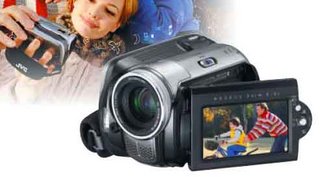
When I analysed the product I found that its editing capabilities were extremely limited, all you could really do in-camera was reorder your movie scenes by creating a playlist. Because the online advertising for this camera claimed you could edit in-camera, I asked people what they expected when they read this, and the views I received were - simple editing, cutting scenes up, and deletion of unwanted scenes. This kind of approach seemed to make sense to me especially as seeing you could attach the camcorder directly to a DVD burner, therefore bypassing a PC that could contain software incorporating these simple editing techniques.
Donald Norman describes in his book “The Design Of Everyday Things” what he deems ‘good’ and ‘bad’ design through case studies and proposes design principles. He extols the importance of design in our everyday lives, and the consequences of errors caused by bad design. He also goes on to talk about designing with the user in mind, simplifying the structure of tasks, making things visible, getting the mapping right, exploiting the powers of constraint, and designing for error.
I have tried to take these principle in to consideration whilst working on my redesign.
I started the redesign by choosing to change the way you edit and alter the style of the menu interface to make it more similar to a mobile phone interface. The users of the camcorder (families, kids, anybody really but the size of the camcorder might put off the visually impaired) should relate well to the mobile phone design metaphor as they should be the same type of user. The Sony Ericsson range of phones also has similar video editing capabilities to my proposed design.

Doing this helped me plan out the vertical functionality and fine-tune the functions I wanted to represent. I then designed a high fidelity prototype in Flash to give user testers a more realistic experience when testing it.
The original MENU listed your options using text and small, animated icons but you had to scroll off screen to find some of the options, as they weren’t all shown on screen at the same time.
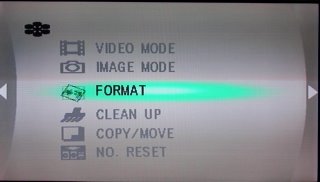

 New editing functions showing users feedback and some of your options
New editing functions showing users feedback and some of your optionsIf I’d had more I time I would have introduced some kind of help function as on websites or a demo video of how to use the functions so that if you forgot how to use a certain function, you’d be able to find out directly from the camera (which has a 20GB hard drive) instead of having to look for your users manual (which invariable gets lost or thrown away).
Wednesday, November 08, 2006
Tuesday, November 07, 2006
Back from Stag Do in Prague
Thursday, November 02, 2006
Locative Aware Services-Locative Media
Many of the various locative media projects researched have concentrated on social interaction with a place and with technology and have a social critical or personal background.
The types of technology that enable locative media are; (GPS) Global Positioning Systems, laptop computers, Palm computers (PDA’s) Personal Digital Assistants, Mobile Phones, Bluetooth and Satellite Navigation Software.
Whilst these technologies are the catalysts for locative media, they are not the goal for the development of projects in this area of research. Rather
"Locative media is many things: A new site for old discussions about the relationship of consciousness to place and other people. A framework within which to actively engage with, critique, and shape a rapid set of technological developments. A context within which to explore new and old models of communication, community and exchange. A name for the ambiguous shape of a rapidly deploying surveillance and control infrastructure." (Russell, 2004)
Context-aware computing represents a relatively new area of research. Context awareness means gathering information from the environment to provide a measure of what is currently going on around the user and the device. Activities and content that are particularly relevant to that environment can then be made available. Mobile devices are especially well suited to context-aware applications simply because they are available in
different contexts, and so can draw on those contexts to enhance the learning activity. Context-aware mobile devices can support learners by allowing a learner to maintain their attention on the world and by offering appropriate assistance when required.
The museum and gallery sector has been on the forefront of context-aware mobile computing by providing additional information about exhibits and displays based on the visitor’s location within them.
User Centre Design-Flash Prototype

Notes from Tuesday Needs and requirements-users-redesign.
Stages
Identify, data collection and analysis, capture.
VOLERE TEMPLATE
Requirements
Tunctional/Env/User/Usability/Data
Prototyping
Paper, storyboards,screenshots
Horizontal-Look of homepage
Vertical-Functions behind the homepage
Screenshots of development of Flash prototype and progress sheet from Wednesday





Tuesday, October 31, 2006
The Big Welsh Challenge
Today Stephen Morgan from BBC Online and Education department came to the lab to test a new Broadband Broadcasting development.
We acted as guinea pigs helping the BBC test their latest development ( as part of The Big Welsh Challenge) This helped give us an inside look at how the BBC go about getting user feedback and testing their prototypes.
I guess it's aimed at teenagers upwards to be used as an alternative to the more cartoonish welsh learning site on the Beeb - Colin & Cumberland
Partitipation session notes
http://dfim-ccs.blogspot.com/2006/10/seminar-four-participation.html
session 5 location aware services/locative media
software and systems that are aware of their locations. Google-earth-maps-multimap. Tom Tom how do they use maps.
Follow Taff Trial no these maps
phones know where they are so you can ask for services near it eg cinemas, banks
Commercial services
Locative media - art term
"The shape of locative media" MUTE by Simon Pope
GPS-Smartphones services
HP USA
Create-a-scape
How stuff works phone technology
Japanese phone GPS
Schengen zone at airports
degree confluence project.
http://dfim-ccs.blogspot.com/2006/10/session-five-location-aware-services.html
Sunday, October 29, 2006
DfIM Assignment 1: Reading a Research Paper
Paper for Evaluation
Examining Mobile Phone Use In The Wild With Quasi-Experimentation.
The motivation for this work is for commercial (funded by Nokia Corporation) research into how users interact with mobile devices and they environment around them on the go as opposed to in a laboratory environment. One problematic issue has been that current methods are not suited for attempting to establish causal relationships between context variables and interaction. In the paper they describe an experimental method, called quasiexperiment, and apparatus for recording mobile phone usage and the environment in a mobile context.
The proposed solution for recording people’s interactions with mobile devices (in this case web browsing on a mobile phone) is to use a series of miniature cameras set up to record;
• The user’s face and eyes
• The phone display and keys
• The environment as seen from the users point of view
• The user and environment as seen by a moderator
Two of the cameras are attached to the phone, another is attached to the shoulder of the user, and the fourth is carried by the modulator disguised as a mobile phone. Images from the four different cameras are combined into one and time coded together to produce a complete record of the users interaction.
In terms of the evaluation of the proposed solution to recording mobile phone use in the wild, they conclude that their portable apparatus allowed them to gather multi-variable data from the different mobile contexts, and that no other study has captured as much data with such a wide range of variables.
They felt that their method would be suitable for other field experiments where device interaction and/or user behaviour and the environment have to be examined.
They claim to have managed to root out relevent and scientifically reliable data about user behaviour in the mobile context. So in terms of purpose they felt the research was a success.
I was persuaded of the merits of the proposed solution in that I agree that putting all 4 camera views together and having the time codes sync up would lend to you gathering all the relevent data you could get from the users interacting with the device. But I do feel that when people on the street question the users about what they are doing, this acts as an unwanted distraction and outside influence that could affect the results.
The future directions for this type of research is primarily to have more easily operated portable, light equipment to be able to record events and environmental circumstances automatically, thus minimizing the need for manual coding and time logging of data collected, which would make it less laborious and time consuming.
Because of cost constraints no portable eye tracking equipment was used in the experiments. Use of this technology in future experiments could provide useful extra data concerning eye movement and attention of the user.
The writers of the paper “hope that future work will hopefully be able to provide better and lighter-weight methodology for system developers and other practitioners to evaluate and examine their applications in the wild”. As I’ve said earlier this method of date collection would lend itself very easily to other field experiments using mobile devices.
While reading and re-reading the paper there were a few things that I didn’t understand:
• I didn’t know that quasi meant “used to show that something is almost, but not completely, the thing described”
• They didn’t explain their reasons for not telling the participants the real purpose of the experiment until the end of their participation.
• I didn’t understand what [Low Experimental Power “experiments in the world are susceptible to low power” page 13] meant.
• I didn’t understand what [The Reliability of Measures “Measures of low reliability may not register true change” page 13] meant.
Bibliography
Virpi Roto, Antti Oulasvirta, Tuulia Haikarainen, Jaana Kuorelahti, Harri Lehmuskallio, Tuomo Nyyssonen. (2004). Examining Mobile Phone Use In The Wild With Quasi-Experimentation. [online].
Available from: http://www.hiit.fi/publications/pub_files/hiit2004-1.pdf
[Accessed 15 Oct 2006]
Gaetano Borriello, Matthew Chalmers, Anthony LaMarca, Paddy Nixon. (2005). Delivering Real-World Ubiquitous Location Systems. [online].
Available from: http://www.lazowska.cs.washington.edu/gb.pdf
[Accessed 17 Oct 2006]
Anne Galloway, Carleton Matthew Ward. (2005). Locative Media As Socialising And Spatialising Practices: Learning From Archeology [online].
Available from http://www.purselipsquarejaw.org/papers/galloway_ward_draft.pdf
[Accessed 17 Oct 2006]
Saturday, October 28, 2006
Yesterdays notes on collecting primary data
- Quantitative
- Qualitative
- Observations
- Interviews
- Questionnaires
Hawthorne affect - might play up for the camera
Which role do I adopt?
Field observation!
Data collection!
Group interviews!
When to use interviews!
- Initial insight
- Follow-up
- Criticalness
- Time available
- Access to responants
- Expertise
- Equipment
- Setting
Question Design!
The DECIDE framework.
Thursday, October 26, 2006
UCD Paper prototypes
Wednesday, October 25, 2006
Todays Notes
Tuesday, October 24, 2006
User Centre Design-Notes
Intro-methology-development-conclusion-reference-bibliography
Ideas- left handed, ambidextrious camcorders.
Lecture Notes
Stages of design
- Develop alternative designs
- conceptual level
- physical level
- building
- test & evaluate
- final development
Lifecycle models
- Traditional waterfall
- Rapid application development RAD
- A simple interaction design model (Preece et al 2002)
USD in my work

- Long Timerecording
unavailable with any
other storage
medium. - No Costfor or need to
buy additional
recording media. - Direct Access
to scenes you want. - No Risk of erasing
something by
mistake. - Easy Deletion
of unwanted scenes. - Simple Editing
is possible by
camera itself.
Playlist function.
Monday, October 23, 2006
Participation
YouTube is one of those mediums that you participate with twofold, not only can anyone watch videos on it but anyone can post videos to it as well. It is a place on the web where you can engage in new ways with video by sharing, commenting on, and viewing. If nobody participated in these ways then YouTube would be as redundant as the shelves at a Betamax video store.
The National Trust is encouraging people to record a diary of their day (the 17th of October 2006) on a website, as part of what is being called "Britain's biggest blog". They are trying to get people to participate and help create a “fascinating social history” archive of everyday life for future generations. People who want to contribute to the project have until the 31st of October 2006 to upload their accounts of the 17th of October 2006.
As you can see from the above examples these new forms of audience participation are nothing without your contributions. The artists of the work are in essence now conductors of a multi varied canvas.
In terms of the work I want to produce I could make use of the YouTube technology to have visitors upload video blogs of their experiences at the memorial sites they have been to.
http://www.art-themagazine.com/pages/tokyo2.htm
http://www.artinteractive.org/curatorial.php
http://www.chapter.org/7088.html
http://www.youtube.com/t/about
http://video.google.co.uk/video_about.html
http://www.historymatters.org.uk/output/page96.asp
http://www.myspace.com/Modules/Common/Pages/AboutUs.aspx
http://en.wikipedia.org/wiki/Wikipedia:About
http://www.e-consultancy.com/news-blog/361871/jakob-nielsen-s-tips-on-increasing-community-participation.html
http://technokitten.blogspot.com/2006/01/participation-tv-as-part-of-mobile.html
Sunday, October 22, 2006
Saturday, October 21, 2006
HND Graduation

Went to Pencoed College today for my HND Graduation Ceremony. I was surprised be the number of other courses also at the ceremony, there was HND's HNC's MBA's and PGCE's from University of Glamorgan, UWIN and UWIC.
Another surprising thing was that I was the only person from my course to actually turn up for the ceremony (obviously all turned off by the price of hiring robes) but their loss I guess. My parents we're very proud and will be even more proud for my big boys graduation next summer.
Monday, October 16, 2006
Sustainability
The awards are open to all types of businesses in both the public and private sectors who are willing to nominate themselves. The event is supported by The United Nations Environment Programme(UNEP), Media Guardian, City of London, Marketing Week and CSR Wire.
"The overall objectives for the Green Awards are as follows:
- To recognise and reward outstanding creative work that communicates sustainability.
- To set the agenda for brands to brief agencies to include CSR within the creative process.
- To create a forum for how the media can help solve some of the environmental issues in a creative way.
- To develop the notion of 'Reform Advertising' i.e. advertising which includes environmental and social considerations during its planning and execution."
According to Mori, 82% of consumers want companies to make more effort to show what social, environmental and fair trade activities they are engaged in. The good news is that many businesses and corporations today see social and environmental issues as being critical to their overall success.”
The field that we work in ideally placed to encourage innovation in sustainable development, by
- practicing greener lifestyles,
- using energy efficient devices,
- producing our own green energy via solar panels and wind turbines,
- fitting in to our environment,
- encouraging social interaction eg blogs,
- recycling technologies,
- producing less waste heavy and toxic products,
- putting people first.
http://www.greenawards.co.uk/
http://www.csr.gov.uk/index.shtml
http://www.forumforthefuture.org.uk/
http://en.wikipedia.org/wiki/Sustainability
http://www.leeds.gov.uk/sustain/
http://environment.guardian.co.uk/columnist/story/0,,1924434,00.html
http://www.hydrogeneration.co.uk/intro.htm
http://www.greenpeace.org.uk/contentlookup.cfm?ucidparam=20060918141449
http://news.bbc.co.uk/1/hi/technology/4445060.stm#
http://news.bbc.co.uk/1/hi/world/africa/6040536.stm
http://laptop.org/
wireless networks review
pico net
The cloud wireless in jukeboxes
Use blimps or balloons to broadcast wireless networks
pringles can antenae
MESH AP
Sunday, October 15, 2006
Free, Open Wireless Networks
To start with I have a wireless network on NETGEAR shared between 2 laptops, which is open and free to use for anyone who wants to try.
Looking from home I found closed networks on BTVOYAGER a network called HORACE and one called SABAD. I then drove round the village with my laptop and found several networks - cxl-wifi, another BTVOYAGER, belkin54g, SABSW, NETGEAR, HILLNET, Livebox-2FAD, WANADOO-550D, linksy_nth, and at Cardiff Wales Airport BT Openzone.
Out of the above only 3 are open wireless networks free to use by anyone who finds them and the others are all secure. The exception to this is the network at the airport which uses BT Openzone. To use this you have to buy access time, walk into a hotspot, which could be a train station, café, shopping centre, restaurant/bar or airport open your wireless laptop or PDA, and connect to the internet using wireless broadband. Although not free to use it does give you access to thousands of public hotspots in the UK and tens of thousands global hotspots worldwide.
A completely free wireless network would allow people greater access to the internet no matter what their income and would create greater mobility of use for laptops and PDA’s.
http://en.wikipedia.org/wiki/Wi-Fi
http://media.guardian.co.uk/site/story/0,,1707753,00.html
http://www.nycwireless.net/articles
http://www.nytimes.com/2006/03/05/technology/05wireless.html?ex=1299214800&en=de3c127408552e0a&ei=5089
http://en.wikipedia.org/wiki/Warchalking
http://news.zdnet.co.uk/communications/wireless/0,39020348,39195421,00.htm
Wednesday, October 11, 2006
UCI - BRIEF THREE


In relation to HCI and usability I would say
• The user is attracted to the game by the motorbike shells, which get you more involved than by just using a joystick. And the fact that there are two bikes means you can interact not just with the computer but with one of your friends as well.
• In regards to health and safety the replicas are designed to move like real bikes but without the dangers of toppling or throwing the users to the floor.
• Before the actual game starts you choose from a range of difficulty levels linked to weather conditions and type of surface. So you can make the task easier or harder depending on your experience of the game.
• Your character gives you immediate feedback on screen as you steer and depending on if your using the throttle or brake, and the noises coming from the game link your actions to the action on screen. Bikes revving and crashes.
• I found the fact that you used the bikes movements less than on other bike games that I’ve played frustrating on my first go because I was bringing what I thought was prior knowledge to the game and getting less feedback than I’d expected.
• In terms of learnability and re-learnability, the instructions are easy to follow and given to you step by step. Once you’ve played it once you’ve unlikely to forget how to use it even after a few months.
• The game is effective in that your involved enough to believe that you’re on a bike racing other bikes round a track. Sitting on a replica adds a sense of reality to the whole experience.
The forms of interaction experienced playing the game are
• Instructing – you are shown instructions on how to use the controls on the replica to help you play the game.
• Manipulating – you can alter the environment (weather/track) and you can choose what you character looks like.
• Exploring – every lap you make helps you explore what the track looks like and where certain hazards might be.
The exhibits at UCI compared to those at Techniquest
• In terms of design they try to entice you and keep you forsaking all other games so that your addicted and spend all your money on that one game. Bur they both use shape and colour in similar ways, its just the time spent at one game or exhibit that differs.
• Are aimed at an over all older target audience, teenagers and young adults (or forever young adults). Especially some of the more gruesome graphic games.
• Are designed more to specifically entertain than educate.
arcadeflyers
Monday, October 09, 2006
Contempory Contextual Studies 3
http://dfim-ccs.blogspot.com/2006/10/seminar-stars-of-cctv.html
Friday, October 06, 2006
Stars of CCTV
I looked at;
• YouTube – which allows anyone to watch and share original videos online.
• Flickr – which allows you to upload and share your photos online either by sending them over the web or via camera phone.
• GoogleVideo – which allows you to upload video, provided you own the necessary rights.
I signed up to all of the above and uploaded a video to YouTube and GoogleVideo and a picture to Flickr. All files uploaded without any problems but YouTube took the longest to load. In terms of getting your work seen by as many people as possible all 3 sites have their uses, you can even integrate the videos directly into blogs or websites and they are all free to use. There are literally millions of images and videos that have been shared worldwide.
I am interested in producing some film or animation work and in this regard I could find using YouTube and GoogleVideo and in some ways Flickr constructive in terms of getting the work seen be an audience with the power of rating my work after viewing it. People can rate the work out of 5 stars, leave a comment or email a link to the video to friends, family or colleagues. By reviewing the responses you can tell if your work is well received and worth marketing to a more profitable kind of mass media such as through TV production or pay per view download.
http://www.youtube.com/
https://upload.video.google.com/
http://www.flickr.com/
http://www.bbc.co.uk/wales/capturewales/
http://www.thetrailermash.com/
Thursday, October 05, 2006
TECHNIQUEST - BRIEF 1


Once you approached the film/music mixer after being attracted to it by its big screen all you do is press the "try me" button on the top left of the left control panel. On pressing this you receive simple on screen instructions to "Press the play button to watch the film".
 The play button is green and is place on the right-hand control panel. It looks like the standard play button that we’re used to on CD/DVD players. Once you’ve pressed it the movie starts to play on the LCD screen on the wall. As you watch it you can see the rate of play in the timeline and it also shows you the audio waveform of the music tracks that you can choose to play along to the video.
The play button is green and is place on the right-hand control panel. It looks like the standard play button that we’re used to on CD/DVD players. Once you’ve pressed it the movie starts to play on the LCD screen on the wall. As you watch it you can see the rate of play in the timeline and it also shows you the audio waveform of the music tracks that you can choose to play along to the video.The main point of the exhibit is to get you to interact with what music is playing along with the video by using the 8 buttons above the play button. The video and audio is split up into 4 segments and by using 2 of the buttons that line up with that segment you can choose between having no music or a choose 1 of the 3 different music tracks in that particular segment.
The user learns how to use the exhibit after the initial instructions by trial and error. You press the buttons on the control panel above the play button and you get immediate visual feedback on screen (where you can see that the track has changed) and audio feedback (you hear a different music track or no music at all).
The target audience as with most of the exhibits on the top floor is older kids – teenagers and young adults. This has influenced the design in that instead of using bright primary colours to attract the user they’ve used orange and purple and a big screen. The interface on screen uses visual cues linked to the music that younger kids are unlikely to understand or appreciate fully, especially the audio waveforms.
The film/music mixer is fun to use, simple to learn (you get immediate visual and audio feedback after pressing a button) and it gives you an insight into how music video’s and film scores are put together which should appeal to the MTV/Ipod generation or whatever they’re called now.
In regards to HCI (human computer interaction) and usability I would say that it was
• Easy to learn and use.
• Memorable, in the fact that you wouldn’t have to relearn a difficult process
• Useful as a teaching and entertainment device
• Flexible, all in all you have 16 options of where you link the music or lack of music to the video.
• Efficient, you only have 4 states to choose from at a time in each of the 4 segments and the only mistake you can really make is not doing anything at all.
• Enjoyable to use and entertaining.
• Good to look at.
I think the exhibits lack of instruction bar “press the play button” encourages a general button bashing and self learning experimentation which aids interaction with the exhibit.
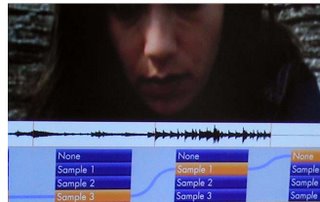
gogglevideo
Wednesday, October 04, 2006
Techniquest
Tuesday, October 03, 2006
Design For Interaction 2
HCI - Human Computer Interaction
- Design, evaluation and implementation
- A bridging
- Humans - Computers
A HCI approach aims to
- Support
- Extend
- Optimisation
- How ?
- Learnability
- Re-learnability Memorable
- Utility
- Flexability
- Effeciency
- Safety
- Effectiveness
- Usability Criteria
- Feel
- Satisfying
- Aesthetically pleasing
- Enjoyable
- Fun
- Entertaining
- Motivating
- Helpful/supportive
- Rewarding
- Emotionally Fullfilling
(Nielsen 2001)
Usability principles useit.com nng.com
CCS Notes
notes for ccs taken by Kirsty
Chatted about what info we’d found out about peer-to –peerNapster or a link – unstructured – p2p
Tapestry – structured p2p
Discreet (closed to outside world) networks for specialised areas
Another social network
History of internet – internet is simply inter networks –
How computer networks mirrored social net
6% of separation we’re all only 6 connections away from each other
Trace through address books 6 times to get to who you want
Hub
http://www.flickr.com/blog.gne?photo=258439096
Small world theory
The hub would be the most likely to know others in different groups
GOOGLE – searches Documents are most trustworthy if there are lots of links to them
Dark net (underground)
Nutella napster – issues behind them p2p – legal issues
List of companies of people are not happy with p2p
E.g. Sony, MGM
Copydex – underground movement – giving music away free
Embrace – play to enjoy music not to make money – hold secret gigs
Don’t believe in the copyright for music – just on name
Pre internet copyright movement
Music Industry
Producers (view) - people listening , merchandising, press & promotions,
How to get known
PureVolume – can lead to record deals
My space –
Distributors – charge – approx 50% of profits
Strategy of promotion
Merchandising
Maintaining brand of the band
Most of the revenue is through merchandising and live events
Self Distribution
Internet promotion
Pod casts
I Tunes 99p download
New bands have pop up of samples
Frattellis
Mass protest against record companies (people power)
Donate money to the band
Using the networks to promote
E.g. DJ’s / bands if you listen \ download a set and you like them you’ll be likely to pay to go and see there next gig/ dj set
Technical p2p
Social p2p
Cultural impact
Marketing – Significant word of mouth
In a peer 2peer networks if you can find the hub you can contact them for their contacts
If you want something rare important it is hard to get into the closed social networks
Spys undercove
Monday, October 02, 2006
PRODUCT ANALYSIS - BRIEF 2

Product Interface Interaction
The product that I have chosen to review is JVC's GZ-MG26 Everio Hard Disk Camcorder. It is portable (handheld and compact), has a multimedia interface (display screen), and has some features that could be redesigned or features that could be introduced.
Description and Functionality
The product itself is a handheld digital camcorder with a built in 20GB hard drive. You can also be use it as a digital camera to take still images. It is built out of a strong black and gunmetal plastic (as are the buttons, knobs and levers) and the lens housing is made out of aluminium.
Shooting is simple. Just flip
 out the LCD monitor screen, select the camera or video mode and press the record button. All photos and video are stored on the large built-in 20 GB hard drive which can hold between 290 to 1500 minutes of video and up to 9999 still images depending on the compression rate and picture
out the LCD monitor screen, select the camera or video mode and press the record button. All photos and video are stored on the large built-in 20 GB hard drive which can hold between 290 to 1500 minutes of video and up to 9999 still images depending on the compression rate and picture  quality.
quality.Judging by its online brochures it's intended users are families in there 20's and 30's who are computer literate and willing to learn simple editing software to produce their own DVDs.
Apart from taking video and stills you can use the camcorder to view these image in its LCD screen or hook it up to a TV monitor or via saving them to a PC. You can re-order the scenes or delete them and add special effects to the playback of the video.
Concerning the environment within which it can be used its mainly designed for daylight conditions but it does contain a white LED and a night scope for darker conditions. You can also buy tripods, flashguns and a marine case for under water shooting up to 30 metres.
To access the functions of the device you mainly use the menu button, the index button and the control lever to move around the display and interact with the onscreen interface menus. In terms of m
 ultimedia you can view what you have recorded on TV, copy it to PC to edit fully from there, or you can burn DVD’s directly onto a “share station DVD burner” and view the footage on any device that plays DVD’s.
ultimedia you can view what you have recorded on TV, copy it to PC to edit fully from there, or you can burn DVD’s directly onto a “share station DVD burner” and view the footage on any device that plays DVD’s.Interface Design
The interfaces look and feel is typical of most camcorders with various symbols, battery levels and other information on top of the footage on screen. But when you press the main menu button th
 e interface is more like a mobile phone menu with animated icons next to text descriptions. Even the control lever, which you use to navigate up, down and left, right through the on screen options is reminiscent of the joystick controls on many mobile phones, especially Sony Ericsson models.
e interface is more like a mobile phone menu with animated icons next to text descriptions. Even the control lever, which you use to navigate up, down and left, right through the on screen options is reminiscent of the joystick controls on many mobile phones, especially Sony Ericsson models.In play mode as opposed to the record mode the interface splits the screen up into 9 rectangles, each one containing a snapshot of the first frame of a video or a photo. If you have more than 9 videos/photos stored on the camcorder a scrollbar appears on the far right showing that you that you can scroll down onto further content. Using the control lever you can view full screen photos or play full screen videos. You can also pause, scan and zoom into the videos and photos using the control lever and the interface.
The interface is easy to use but when using the menu functions you really need to have the users manual to hand to know where to look for relevant functions and what they do. Using trial and error here would just lead to a lot of errors and you would lose track of where you’ve been. When in play mode, since its all visual you can instantly see where you are and what videos/photos are only one click away. This instant feedback is more user friendly and invites more trial and error interaction because your only one click back to its main interface so its hard to go wrong and lose yourself.
In terms of human cognitive processes I would say that the interface
• grabs your attention with its use of animated icons.
• in terms of perception uses easily distinguishable icons but not all of them have obvious representation.
• in terms of memory and learning has some actions in common with other camcorders which aids the learning experience if you have prior knowledge to bring to the device but would be difficult to master if you didn’t have a user manual to refer to.
Task Analysis
The online brouchures mention that you can perform simple editing in camera, so this is the task I’ll try to analyse. First of all you have to create a playlist which will enable you to organise recorded video in order of preference. To do this you select the power switch to the play mode; set the mode switch to video; press the menu button; then select the “playlists contents” option on screen; choose “NEW LIST”; then select a file from the scenes you have saved on the camcorder to add to the playlist; when using multiple files in the playlist you can choose the exact order you want the scenes to run or delete unwanted files; when you’ve finished your playlist, save and quit. To pl
 ay the playlist when in the “playlist contents” screen select your required playlist and use the toggle switch to play/pause or stop the scene.
ay the playlist when in the “playlist contents” screen select your required playlist and use the toggle switch to play/pause or stop the scene.To perform this task you definitely need to have the users manual to hand (which is 70 pages long and printed in black and white). But once your on the editing screen you’ll find the interface is really easy to use. The left of the screen has all the scenes on the disc, which you can scroll through and the right of the screen is where you place the scenes that you have chosen in the order that you want them.


